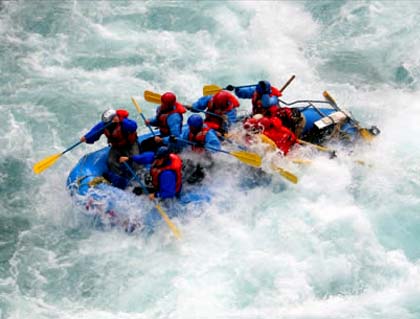

Rafting in Nepal:Nepal's most loved adventure sport

When roaring white water current flow beneath the clearest, brightest, blue sky; you know it's the time for some white river rafting, "As all major rivers get flooded during summer, autumn and spring become the ideal time to enjoy this exhilarating sport," says Shree Shrestha, the proprietor of Ultimate Rivers co.
Did you know, however, that rafting is not just limited to a one-day-affair but can prolong to days in end?
According to data collected, rafting junkies have opted for these extreme trips-
> Trishuli Rivers (1-3 days),
> Bhote Khoshi River (2 days),
> Kali Gandaki River (3 days),
> Marsyandi River (4 days),
> Sun Koshi River (7 to 9 days),
> Arun River (9 days) , Karnali River (10 days) and
> Tamor River (11 days).
When asked which river is the most popular when it comes to rafting, "All major high current rivers are exploited during the rafting season. However, as far as the proximity with the city and duration of the raft journey is concerned, I'd have to say Trishuli is the most-preferred river when it comes to rafting," remarks Rabindra Adhikari, the co-owner of Adrift Adventure in Thamel. "Trishuli rapids aren't very challenging and are the most apt for amateurs. Therefore, a hit with the people", he adds.
Rafting in easy bites
The best seasons for rafting are autumn (September, October and November) and spring (March, April and May)
Popular Destinations include Trishuli and Lower Bhote Koshi for beginners and upper Bhote Koshi for professionals. The extreme adventure junkies choose the more challenging rivers like Kali Gandaki, Seti, Sun Koshi and Karnali.
The Pricing for this thrilling adventure may vary depending on rafting agencies. However, the approximate price range for a one-day rafting adventure may fall somewhere between Rs.1800 - Rs.2200 for Nepalis and 30$ to 40$ for foreigners per person.
A few must-have personal items that you need to pack up when out on a rafting trip are:
1) Strap-on sandals that hold on tight to your feet even when braving the toughest river currents
2) High SPF sunscreen lotion
3) Spare clothes, well, for obvious reasons
4) Water-proof camera if you have one. Although, chances are that you won't have the time to click pictures when battling the romping water currents. But there's no harm in trying it anyway, right?
source: The Himalayan Times
photo:nepalhimalayastrekking








